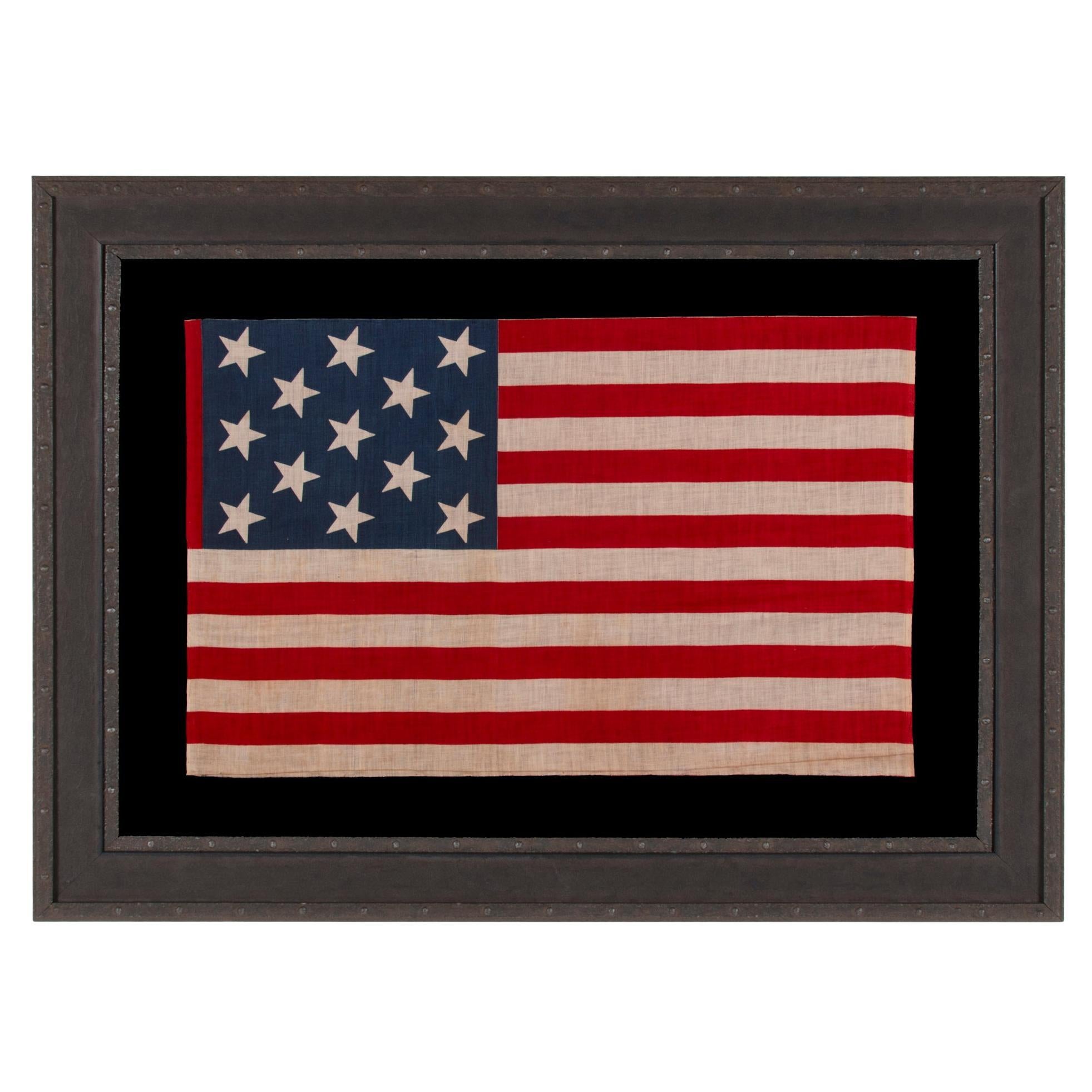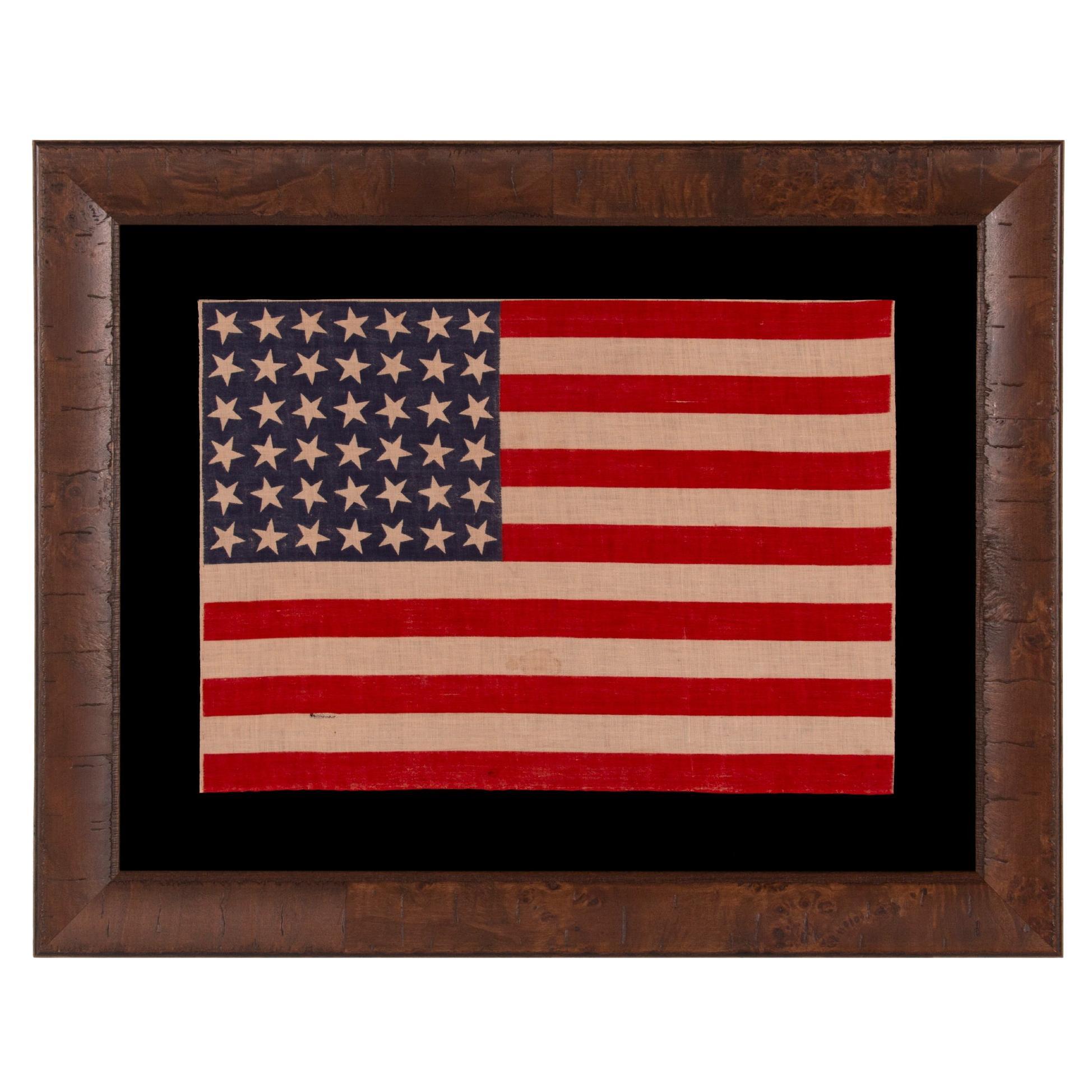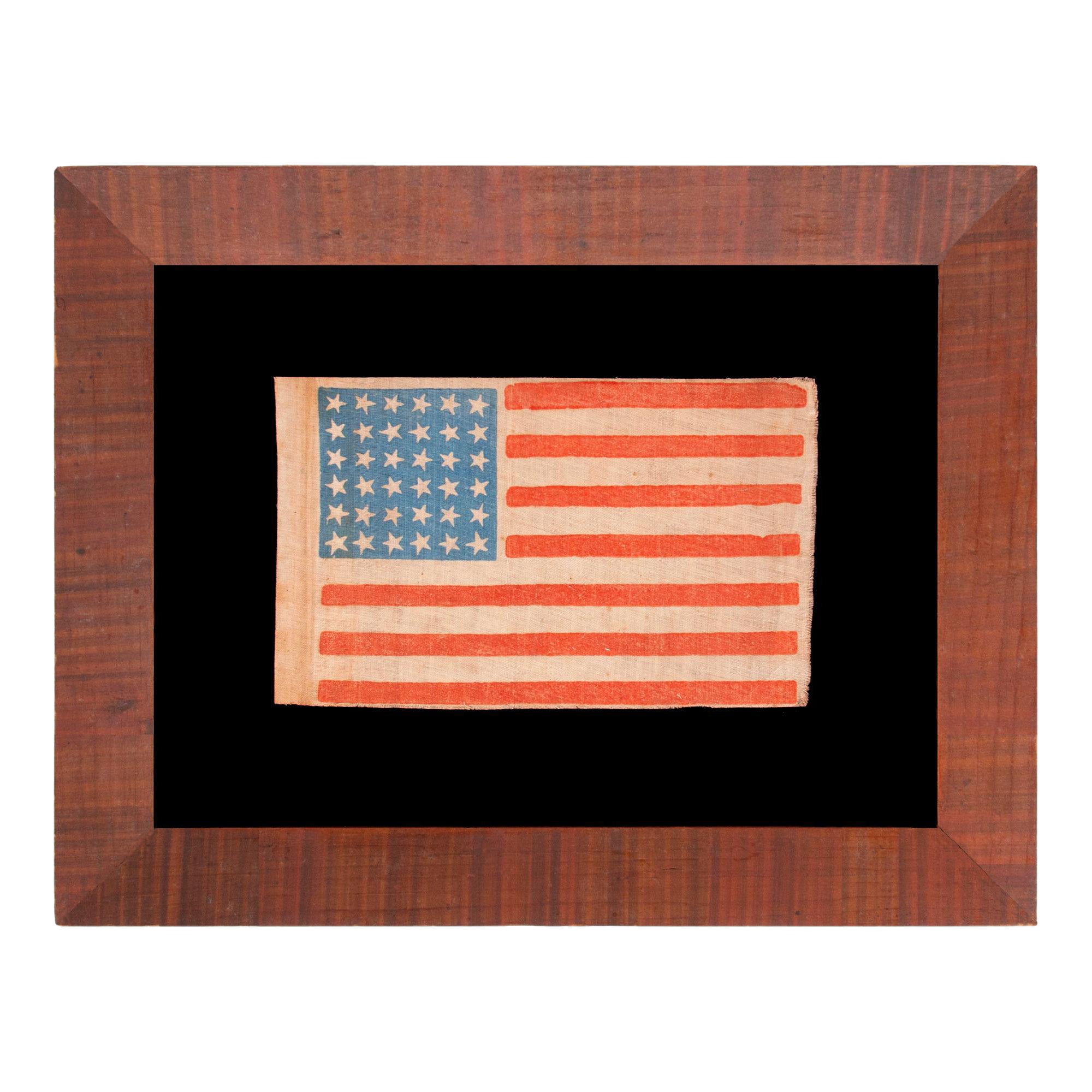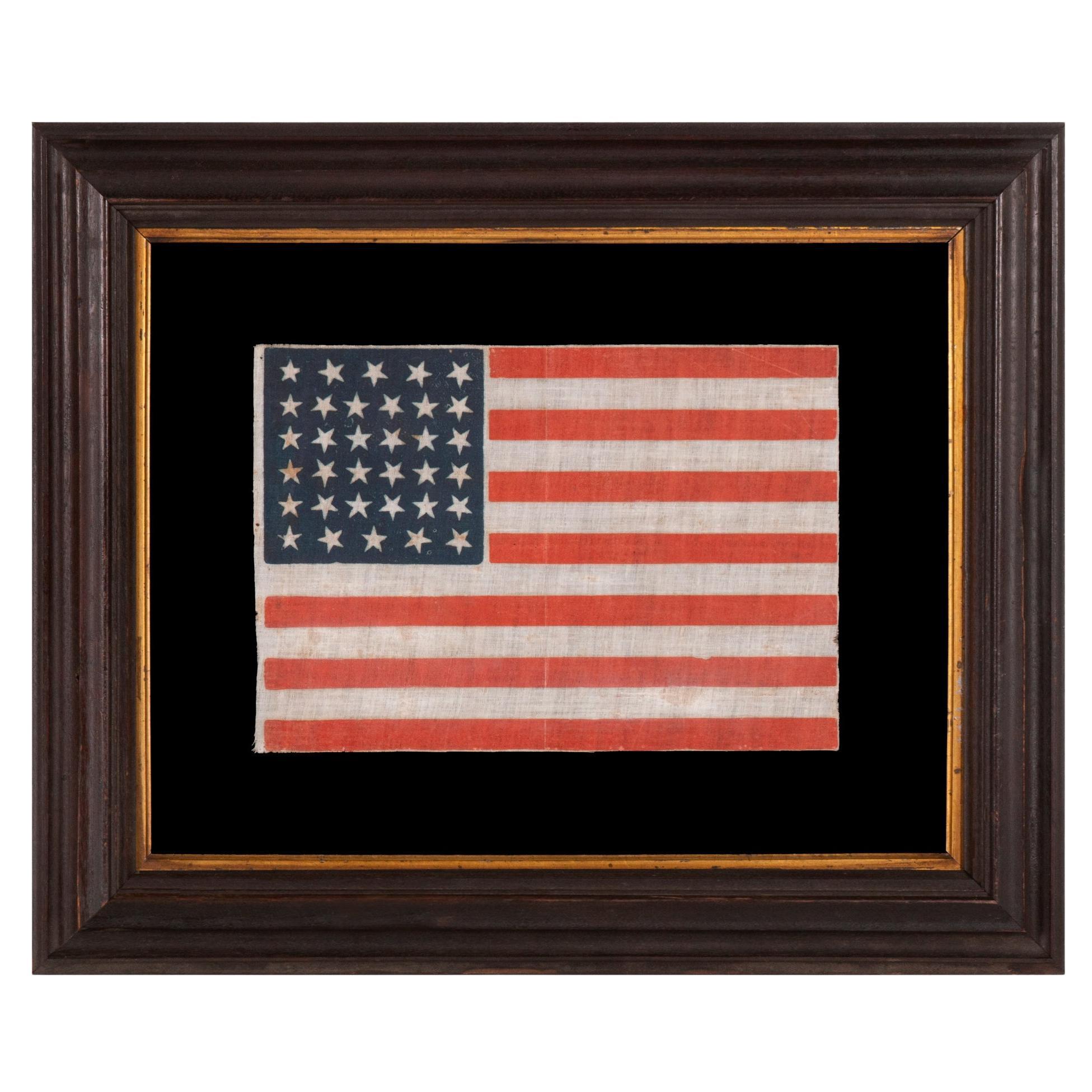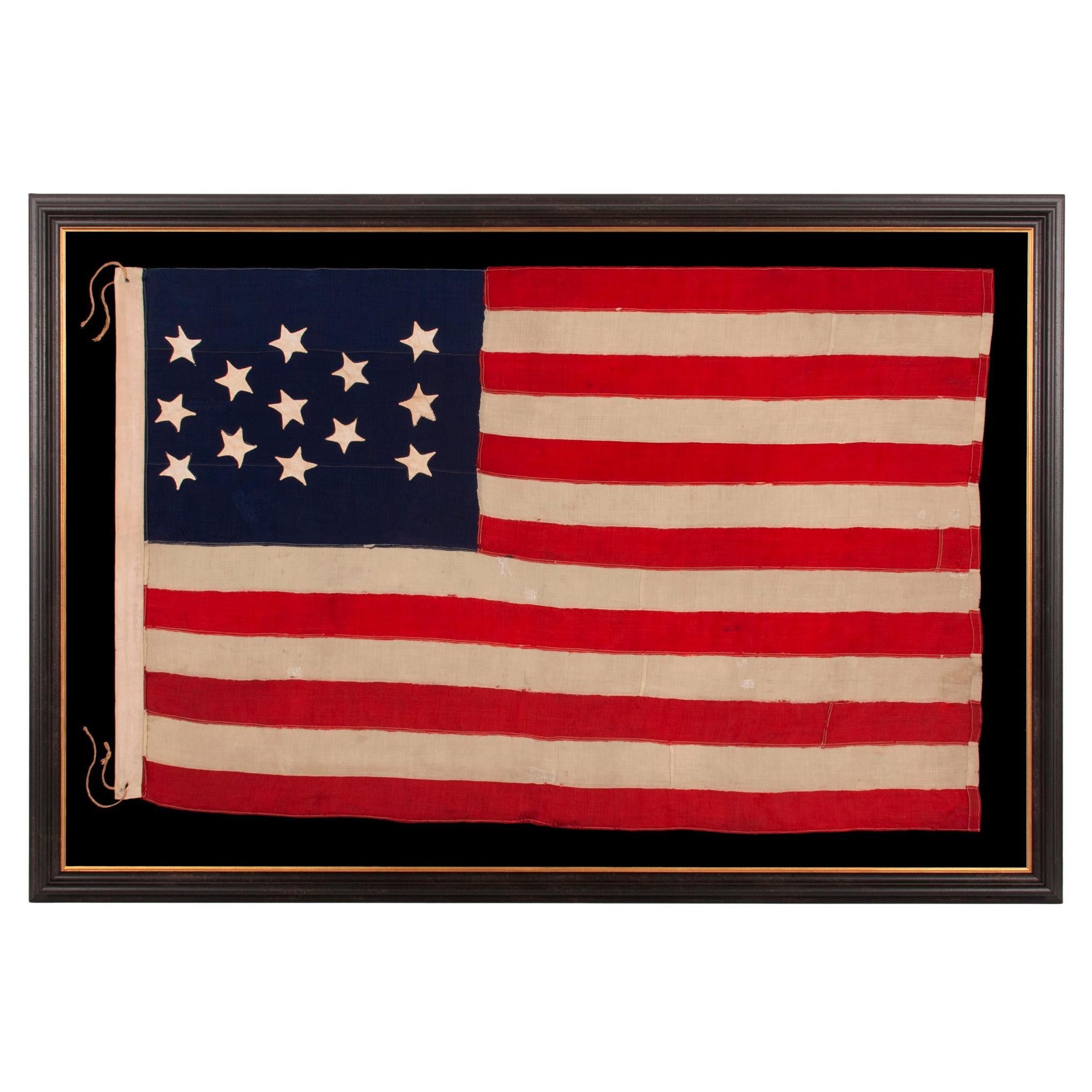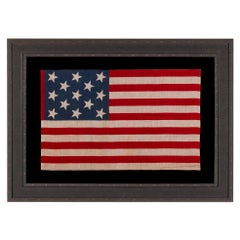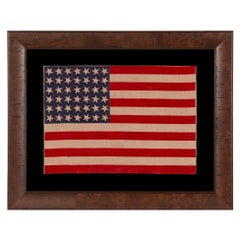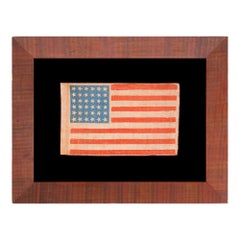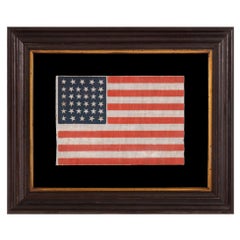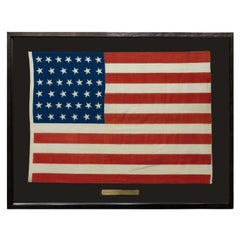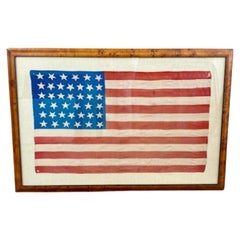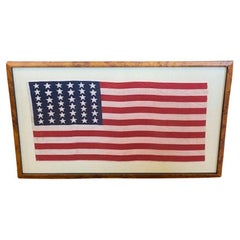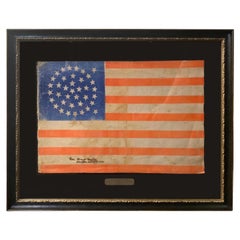Items Similar to 39 Star Antique American Parade Flag with Stars in Two Sizes, Ca 1876
Want more images or videos?
Request additional images or videos from the seller
1 of 6
39 Star Antique American Parade Flag with Stars in Two Sizes, Ca 1876
$3,650
£2,790.62
€3,214.23
CA$5,114.77
A$5,710.16
CHF 2,992.04
MX$69,897.95
NOK 37,998.90
SEK 35,828.14
DKK 23,988.13
Shipping
Retrieving quote...The 1stDibs Promise:
Authenticity Guarantee,
Money-Back Guarantee,
24-Hour Cancellation
About the Item
39 STARS IN TWO SIZES, ALTERNATING FROM ONE COLUMN TO THE NEXT, ON AN ANTIQUE AMERICAN PARADE FLAG WITH AN UNUSUALLY ELONGATED PROFILE, DATING TO THE 1876 CENTENNIAL, NEVER AN OFFICIAL STAR COUNT, REFLECTS THE ANTICIPATED ARRIVAL OF COLORADO AND THE DAKOTA
39 star American parade flag, printed on cotton bunting. This is one of only three styles known that use stars in two different sizes to make columns of equal height, all of which occur in the 39 star count and were probably produced by the same maker. Of equal interest is the exaggerated length of this particular design, which adds considerable impact to its unique graphics.
39 star flags were made at two different times in the late 19th century. The first were made in 1876 in anticipation of the addition of two new states. Only one of these was added (Colorado on August 1st), which brought the star count to 38. This meant that the 39 star flags made in this year were inaccurate. Thirteen years later, 39 star flags were made again with the anticipation of the addition of the Dakota Territory. On November 2nd of 1889, the Dakotas came in as two different states (North & South), which forever rendered 39 star flags both obsolete and unofficial.
In some cases, flag makers may have saved the 1876 print designs and used them again in 1889. It is also possible that some 39 star flags may have remained in the stock rooms of flag-makers and dry goods stores for more than a decade, to be brought out again when the actual addition of the 39th state once again loomed on the horizon. Based upon the fact that other examples with columns of stars in 2 sizes are known to have been incorporated into quilts made to celebrate our nation's 1876 centennial of independence, logic suggests that this flag is likewise of the earlier variety. In any event, the existence of 39 star flags is a classic display of both American capitalism and expansionist ideals for the growth of our nation.
Mounting: For 25 years we have maintained a specialized department for this purpose. Our lead conservator holds a master's degree in textile conservation from one of the nation’s top university programs. We take great care in the mounting and preservation of flags and related textiles and have preserved thousands of examples.
The black-painted, hand-gilded and distressed molding is Italian. The background is 100% cotton twill, black in color. Spacers keep the textile away from the glazing, which is U.V. protective glass. Feel free to contact us for more details.
Condition: Exceptional for the period. There is extremely minor soiling in very limited areas.
- Dimensions:Height: 22.25 in (56.52 cm)Width: 34.75 in (88.27 cm)Depth: 2 in (5.08 cm)
- Materials and Techniques:
- Place of Origin:
- Period:
- Date of Manufacture:1876
- Condition:See Item Description.
- Seller Location:York County, PA
- Reference Number:Seller: 39j-8601stDibs: LU849743316162
About the Seller
5.0
Recognized Seller
These prestigious sellers are industry leaders and represent the highest echelon for item quality and design.
Established in 1991
1stDibs seller since 2008
70 sales on 1stDibs
Typical response time: 1 to 2 days
- ShippingRetrieving quote...Shipping from: York County, PA
- Return Policy
Authenticity Guarantee
In the unlikely event there’s an issue with an item’s authenticity, contact us within 1 year for a full refund. DetailsMoney-Back Guarantee
If your item is not as described, is damaged in transit, or does not arrive, contact us within 7 days for a full refund. Details24-Hour Cancellation
You have a 24-hour grace period in which to reconsider your purchase, with no questions asked.Vetted Professional Sellers
Our world-class sellers must adhere to strict standards for service and quality, maintaining the integrity of our listings.Price-Match Guarantee
If you find that a seller listed the same item for a lower price elsewhere, we’ll match it.Trusted Global Delivery
Our best-in-class carrier network provides specialized shipping options worldwide, including custom delivery.More From This Seller
View All13 Star Antique American Parade Flag, ca 1876-1899
Located in York County, PA
13 STAR ANTIQUE AMERICAN PARADE FLAG, WITH A 3-2-3-2-3 CONFIGURATION OF STARS, AN EXTREMELY SCARCE AND UNUSUALLY LARGE VARIETY, MADE circa 1876-1899
13 star American national parade...
Category
Antique Late 19th Century Canadian Political and Patriotic Memorabilia
Materials
Cotton
Price Upon Request
42 Star Parade Flag with Scattered Stars, ca 1889-1890
Located in York County, PA
42 STARS ON AN ANTIQUE AMERICAN FLAG WITH SCATTERED STAR POSITIONING, REFLECTS THE ADDITION OF WASHINGTON STATE, MONTANA, AND THE DAKOTAS, NEVER AN OFFICIAL STAR COUNT, circa 1889-18...
Category
Antique Late 19th Century American Political and Patriotic Memorabilia
Materials
Cotton
36 Star Antique American Parade Flag, with Canted Stars, ca 1864-1867
Located in York County, PA
36 STAR ANTIQUE AMERICAN PARADE FLAG WITH CANTED STARS IN DANCING ROWS, ON A BEAUTIFUL, CORNFLOWER BLUE CANTON; CIVIL WAR ERA, NEVADA STATEHOOD, 1864-1867
36 star antique American f...
Category
Antique 1860s American Political and Patriotic Memorabilia
Materials
Cotton
Price Upon Request
34 Star Antique American Parade Flag, Kansas Statehood, ca 1861-1863
Located in York County, PA
34 STARS, WITH SCATTERED POSITIONING, ON AN ANTIQUE AMERICAN PARADE FLAG MADE DURING THE OPENING TWO YEARS OF THE CIVIL WAR, 1861-63, KANSAS STATEHOOD
34 star American national flag...
Category
Antique 1860s American Political and Patriotic Memorabilia
Materials
Cotton
Price Upon Request
13 Star Antique American Flag with a Narrow Star Presentation, ca 1876
Located in York County, PA
13 STAR ANTIQUE AMERICAN FLAG WITH HAND-SEWN STARS IN AN EXTREMELY NARROW PRESENTATION OF A 3-2-3-2-3 ARRANGEMENT ON A CANTON THAT DOESN’T FOLLOW SUIT, LEAVING WIDE EXPANSES OF BLUE ...
Category
Antique 1870s American Political and Patriotic Memorabilia
Materials
Wool
Price Upon Request
42 Stars on a Antique American Parade Flag, Washington Statehood, ca 1889-1890
Located in York County, PA
42 STARS ON AN ANTIQUE AMERICAN FLAG WITH A WAVE CONFIGURATION OF LINEAL COLUMNS, AN UNOFFICIAL STAR COUNT THAT REFLECTS THE ADDITION OF WASHINGTON STATE, MONTANA, AND THE DAKOTAS, c...
Category
Antique Late 19th Century American Political and Patriotic Memorabilia
Materials
Cotton
You May Also Like
39-Star Antique American Flag with 'Whimsical' Star Pattern, 1889
Located in Colorado Springs, CO
This is a 39-star unofficial American flag, handmade and printed on cotton. The flag dates to 1889 and has a unique history, thanks to its rare star-count.
The flag’s canton is prin...
Category
Antique 1880s American Political and Patriotic Memorabilia
Materials
Cotton
19th Century American 39 Star Flag, circa 1889
Located in Nantucket, MA
19th Century American 39 Star Flag, circa 1889, a period printed silk parade flag with a wavy pattern of dancing stars. This was never an official flag of the United States but was m...
Category
Antique 1880s American Federal Political and Patriotic Memorabilia
Materials
Silk
19th Century 39 Star American Flag, circa 1889
Located in Nantucket, MA
19th Century 39 Star American Flag, circa 1889, a printed linen ensign with 39 stars arranged in a wavy star pattern, with stripes in a very unus...
Category
Antique 1880s American Federal Political and Patriotic Memorabilia
Materials
Linen
38-Star American Parade Flag, Flown at a Reception for President Grant, 1880
Located in Colorado Springs, CO
This is a beautifully colored 38-star American parade flag, flown at a public reception for Ulysses S. Grant in October of 1880. This printed flag features a rare, triple medallion s...
Category
Antique 1880s American Political and Patriotic Memorabilia
Materials
Cotton
31-Star Printed American Flag, Celebrating California Statehood, Circa 1850
Located in Colorado Springs, CO
This is a rare 31-star medallion printed American flag, celebrating the addition of California to the Union. The flag is printed on silk and has a spectacular “Great Star” canton pat...
Category
Antique 1850s American Political and Patriotic Memorabilia
Materials
Silk
48-Star Printed American Flag, Commemorating Arizona Statehood, 1912-1958
Located in Colorado Springs, CO
This is an original 48-star American parade flag, celebrating Arizona statehood. A wonderful product of our nation's early history, this flag is an authentic antique, with a fly date...
Category
Mid-20th Century American Political and Patriotic Memorabilia
Materials
Fabric
More Ways To Browse
19th Century American Flag
Centennial 1876
American Flag Cotton
Space Memorabilia
Antique Cotton Quilts
Antique American Quilts
1889 Flag
Leaded Glass Display Case
Star Quilt
1876 American Flag
Antique Quilt Top
Antique Star Quilt
Flag Quilt
39 Star American Flag
39 Star Flag
38 Star Flag
38 Star American Flag
Antique 38 Star American Flag
